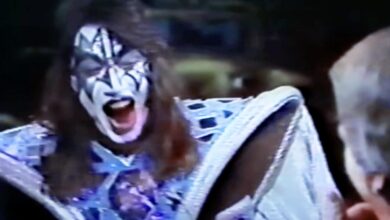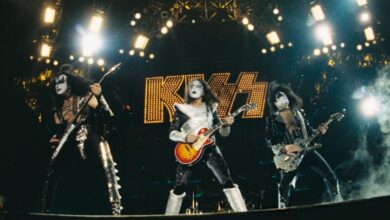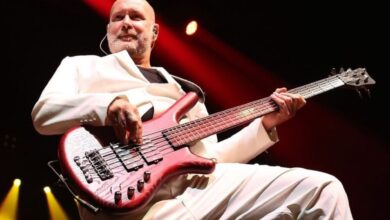The 10-Year-Old Guitar Prodigy Who Brought Rock and Roll Back to Life on AGT 2025
On July 8, 2025, during Night 6 of the Season 20 auditions, Bay Melnick Virgolino stepped onto the AGT stage with the kind of calm usually reserved for veteran road dogs. He grinned, slung on a PRS that looked nearly as tall as he was, and launched into a Lenny Kravitz barn-burner. The phrasing was crisp, the right hand ferocious, and the attitude unmistakable—he played like someone who’d spent years in rehearsal rooms, not elementary school. By the time he’d hit the last flourish, the judges were nodding along and the crowd sounded like a hockey arena in overtime. It was the moment America learned his name.
What made that audition hit wasn’t just chops; it was the way Bay treated the instrument as a voice. He didn’t hide behind distortion. He leaned into space, left pockets of air for the band to breathe, and used vibrato like punctuation. Offstage, the profile only grew: coverage from mainstream entertainment outlets highlighted how the young New Yorker had begged for lessons as a little kid and chased that obsession with the stamina of a lifer. It’s the kind of backstory that can sound manufactured on TV—except his playing kept proving it wasn’t.
That first performance also rippled outward in a way few auditions do. Lenny Kravitz himself noticed, with entertainment press noting the social media nod that effectively knighted Bay in front of a national audience. It’s rare air when your audition performance earns a co-sign from the artist you just covered, and it shifted the Bay conversation from “promising kid” to “serious player.” For a 10-year-old to provoke that reaction showed how neatly he’d bridged generations—older rock fans recognized the tone and phrasing; younger viewers recognized the fearlessness.
By late August, Bay returned for the live Quarterfinals, closing the show with Joan Jett & the Blackhearts’ stadium-stomper. The production was amped—lights, smoke, full band—but the core was still guitar first, everything else second. Judges praised the attitude and the commitment; critiques about vocals popped up, too, the kind that follow any guitarist who also sings on a big TV stage. What mattered most was the room: it erupted. America agreed, and Bay advanced to the Semifinals, the rare kid act whose momentum seemed to grow the closer the stakes got.
NBC’s recap the next day put numbers to the feeling: Bay scored enough votes to make the Top 3 of his episode, punching his ticket to the next round. If the audition revealed talent, the Quarterfinals proved durability—could he scale it up live, with television’s pressure, in real time? The result said yes. He was suddenly part of the season’s central narrative, a throwback rocker surfing a modern voting wave.
The schedule around that week captured just how compressed (and intense) the AGT machine can be. Tuesday night live show, Wednesday results, press cycle spinning by Thursday—then it’s back to rehearsal and arrangement decisions. NBC’s August grid underscored that churn: Bay wasn’t just in a TV competition; he was in a weekly sprint where tiny artistic decisions determine national impressions within minutes. Navigating that pace is a test in itself, especially for a kid fronting a band.
As September rolled in, Bay’s Semifinal strategy signaled a bolder, myth-tapping move: The Who’s “My Generation,” a song whose DNA practically invites chaos and catharsis. The televised package and performance framed him not as a novelty but as a rock historian in miniature—someone who understood that aggression can be art when it’s channeled. Watching him bite into those riffs, lock with the drums, and own the middle of a massive soundstage, you could feel the production trusting him with wide shots and long cuts. That’s TV language for: this kid commands the frame.
There was also the Semifinal twist: switching gears into Steppenwolf’s “Born to Be Wild” in show promos and platform posts, Bay telegraphed that he wasn’t clutching one lane—he was curating a lineage. ‘60s rebellion, ‘70s swagger, ‘90s grit from the audition—he was building a miniature rock survey course across episodes. For viewers who track setlists like sports stats, it felt intentional: a kid mapping his influences in prime time.
By now, the conversation wasn’t just about finger speed; it was about feel. Guitar magazines and gear-heads noticed: his touch, his use of dynamics, and that unteachable “frontman” instinct whenever the camera drifted close. It’s the little things—how he plants his feet before a chorus hit, or the look he throws the drummer ahead of a break—that signal a performer rather than a prodigy. And those details kept getting called out in music-press write-ups, which positioned Bay less as a TV-show curiosity and more as a young artist on a proper trajectory.
The Semifinal results night was a heart-rate spike for Bay fans. Voting was brutal; the talent stack felt even tighter than previous weeks. When the dust settled, outlets chronicled the names moving forward—and the names that barely missed. Bay fell into the latter group, edged out as the field crystallized. In pure TV terms, it stung; in career terms, it was gasoline. Many acts fade after elimination. The chatter around Bay only sharpened, couching his exit as one of those AGT pivot points audiences debate for seasons.
What made his run special—audition to Semis—was that it felt like a restoration project for guitar culture on network TV. AGT regularly hosts instrumentalists, but it’s rare to see a player this young command rock history’s biggest anthems without looking dwarfed by them. Bay’s tone choices, the band’s support, and the show’s willingness to give him live-band muscle made each week feel like a proper gig, not just a talent-show slot. The end result: a wider audience relearning that a loud guitar, played with conviction, is still one of entertainment’s most reliable thrills.
There were ripple effects beyond the scoreboard. Coverage highlighted how Kravitz’s nod helped validate Bay’s audition. Judges’ quotes praising his “attitude” and the crowd’s response in the Quarterfinals gave him a brand: not just “kid who can play,” but “kid who can own a moment.” For a young performer, that distinction matters; it’s the difference between viral clip and viable career. And that’s the road Bay seemed to be laying stone by stone across the season.
On social media, the narrative grew legs. Clips of “I Love Rock ’n’ Roll” rocketed across the AGT ecosystem; promos for “Born to Be Wild” hit Facebook and YouTube with fan calls to vote. Even the inevitable forum debates—was he “too rock” for a pop-leaning vote, did vocals matter more than guitar in this format—only amplified his reach. When message boards bicker about your artistry, you’ve already won a certain kind of relevance.
Another under-told piece of Bay’s story is stagecraft. It’s not just where you put your fingers; it’s where you put your eyes. Bay’s camera awareness, his habit of “selling” big downbeats with a head shake or a stomp, and his gift for landing on the front riser at the exact moment a chorus explodes—those are learned behaviors, and he learned them fast. The live-show cadence demanded it. He met the moment with the instincts of someone twice his age, the kind of instincts that make music directors think, “Yeah, we can build a televised moment around this kid.”
By September’s end, Season 20 crowned a winner, and Bay’s name wasn’t it. But entertainment outlets that recapped the season’s biggest arcs kept returning to him as the breakout instrumentalist—a miniature standard-bearer for guitar on a pop-dominant soundstage. The through-line from audition to Semis created a tidy narrative: a 10-year-old New Yorker, armed with classic-rock canon and modern-TV fearlessness, reminding millions what live guitar can do. That’s a bigger win than a trophy; that’s cultural residue.
Stepping back, it’s easy to imagine where this goes. Post-AGT bookings. Collabs with legacy players who see a bit of their younger selves in him. Maybe a summer festival slot where the stakes aren’t a scoreboard but a crowd on grass, hands up, discovering that real-time electricity again. He has the raw materials: a tone that cuts through TV mixes, an ear for hooks, and a presence that sells the downbeat. AGT gave him a national runway. His playing did the rest—and that’s why this run felt special night after night.
For anyone catching up, the essential beats are clear: the July 8 audition that lit the fuse; the late-August Quarterfinals closer that vaulted him into the Semis; and the September set where he tackled rock’s sacred texts with a grin and a growl. The scoreboard says the journey paused. The footage says it just began.





